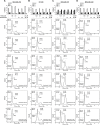Combination of palbociclib with enzalutamide shows in vitro activity in RB proficient and androgen receptor positive triple negative breast cancer cells
- PMID: 29261702
- PMCID: PMC5737960
- DOI: 10.1371/journal.pone.0189007
Combination of palbociclib with enzalutamide shows in vitro activity in RB proficient and androgen receptor positive triple negative breast cancer cells
Abstract
Objectives: Triple negative breast cancer (TNBC) lacks specific drug targets and remains challenging. Palbociclib, a cyclin-dependent kinases 4 and 6 (CDK4/6) inhibitor is approved for metastatic estrogen receptor (ER)-positive and human epithermal growth factor 2 (HER2)-negative breast cancer. The nature of cell cycle inhibition by palbociclib suggests its potential in TNBC cells. Retinoblastoma (RB, a known substrate of CDK4/6) pathway deregulation is a frequent occurrence in TNBC and studies have revealed that pharmacological CDK4/6 inhibition induces a cooperative cytostatic effect with doxorubicin in RB-proficient TNBC models. In addition, recent studies reported that anti-androgen therapy shows preclinical efficacy in androgen-receptor (AR)-positive TNBC cells. Here we examined the effect of palbociclib in combination with an anti-androgen enzalutamide in TNBC cells.
Method: MDA-MB-453, BT-549, MDA-MB-231 and MDA-MB-468 TNBC cell lines were used for in vitro studies. Protein expressions were assessed by Western blot analysis. Cytostatic effect was examined by MTT assay. Cell cycle and apoptosis were examined by flow cytometry.
Results: Palbociclib showed inhibitory effect in RB-proficient TNBC cells, and enzalutamide inhibited cell viability in AR-positive TNBC cells. Enzalutamide treatment could enhance the palbociclib-induced cytostatic effect in AR-positive/RB-proficient TNBC cells. In addition, palbociclib-mediated G1 arrest in AR-positive/RB-proficient TNBC cells was attenuated by RB knockdown.
Conclusion: Our study provided a preclinical rationale in selecting patients who might have therapeutic benefit from combining CDK4/6 inhibitors with AR antagonists.
Conflict of interest statement
Figures






Similar articles
-
Combined inhibition of CDK4/6 and AKT is highly effective against the luminal androgen receptor (LAR) subtype of triple negative breast cancer.Cancer Lett. 2024 Nov 1;604:217219. doi: 10.1016/j.canlet.2024.217219. Epub 2024 Sep 6. Cancer Lett. 2024. PMID: 39244005
-
Synergistic anti-cancer activity of CDK4/6 inhibitor palbociclib and dual mTOR kinase inhibitor MLN0128 in pRb-expressing ER-negative breast cancer.Breast Cancer Res Treat. 2019 Apr;174(3):615-625. doi: 10.1007/s10549-018-05104-9. Epub 2019 Jan 3. Breast Cancer Res Treat. 2019. PMID: 30607633 Free PMC article.
-
Targeting CDK7 Enhances the Antitumor Efficacy of Enzalutamide in Androgen Receptor-Positive Triple-Negative Breast Cancer by Inhibiting c-MYC-mediated Tumorigenesis.Mol Cancer Ther. 2025 Jun 4;24(6):870-883. doi: 10.1158/1535-7163.MCT-23-0386. Mol Cancer Ther. 2025. PMID: 39588561
-
Role of the androgen receptor in triple-negative breast cancer.Clin Adv Hematol Oncol. 2016 Mar;14(3):186-93. Clin Adv Hematol Oncol. 2016. PMID: 27058032 Free PMC article. Review.
-
Androgen Receptor Biology in Triple Negative Breast Cancer: a Case for Classification as AR+ or Quadruple Negative Disease.Horm Cancer. 2015 Dec;6(5-6):206-13. doi: 10.1007/s12672-015-0232-3. Epub 2015 Jul 23. Horm Cancer. 2015. PMID: 26201402 Free PMC article. Review.
Cited by
-
Carcinogenesis of Triple-Negative Breast Cancer and Sex Steroid Hormones.Cancers (Basel). 2021 May 25;13(11):2588. doi: 10.3390/cancers13112588. Cancers (Basel). 2021. PMID: 34070471 Free PMC article. Review.
-
The Potential of PSMA as a Vascular Target in TNBC.Cells. 2023 Feb 8;12(4):551. doi: 10.3390/cells12040551. Cells. 2023. PMID: 36831218 Free PMC article.
-
Diverse role of androgen action in human breast cancer.Endocr Oncol. 2022 Aug 22;2(1):R102-R111. doi: 10.1530/EO-22-0048. eCollection 2022 Jan. Endocr Oncol. 2022. PMID: 37435447 Free PMC article. Review.
-
Updates on the CDK4/6 Inhibitory Strategy and Combinations in Breast Cancer.Cells. 2019 Apr 6;8(4):321. doi: 10.3390/cells8040321. Cells. 2019. PMID: 30959874 Free PMC article. Review.
-
The Combination of the CDK4/6 Inhibitor, Palbociclib, With the Vitamin D3 Analog, Inecalcitol, Has Potent In Vitro and In Vivo Anticancer Effects in Hormone-Sensitive Breast Cancer, But Has a More Limited Effect in Triple-Negative Breast Cancer.Front Endocrinol (Lausanne). 2022 Jun 17;13:886238. doi: 10.3389/fendo.2022.886238. eCollection 2022. Front Endocrinol (Lausanne). 2022. PMID: 35784555 Free PMC article.
References
-
- Gelmon K, Dent R, Mackey JR, Laing K, McLeod D, Verma S. Targeting triple-negative breast cancer: optimising therapeutic outcomes. Ann Oncol. 2012;23(9):2223–34. doi: 10.1093/annonc/mds067 - DOI - PubMed
-
- Kobayashi K, Ito Y, Matsuura M, Fukada I, Horii R, Takahashi S, et al. Impact of immunohistological subtypes on the long-term prognosis of patients with metastatic breast cancer. Surg Today. 2016;46(7):821–6. doi: 10.1007/s00595-015-1252-x - DOI - PubMed
-
- Malorni L, Shetty PB, De Angelis C, Hilsenbeck S, Rimawi MF, Elledge R, et al. Clinical and biologic features of triple-negative breast cancers in a large cohort of patients with long-term follow-up. Breast Cancer Res Treat. 2012;136(3):795–804. doi: 10.1007/s10549-012-2315-y - DOI - PMC - PubMed
-
- Mayer IA, Abramson VG, Lehmann BD, Pietenpol JA. New strategies for triple-negative breast cancer—deciphering the heterogeneity. Clin Cancer Res. 2014;20(4):782–90. doi: 10.1158/1078-0432.CCR-13-0583 - DOI - PMC - PubMed
-
- Toogood PL, Harvey PJ, Repine JT, Sheehan DJ, VanderWel SN, Zhou H, et al. Discovery of a potent and selective inhibitor of cyclin-dependent kinase 4/6. J Med Chem. 2005;48(7):2388–406. doi: 10.1021/jm049354h - DOI - PubMed
MeSH terms
Substances
LinkOut - more resources
Full Text Sources
Other Literature Sources
Research Materials
Miscellaneous

